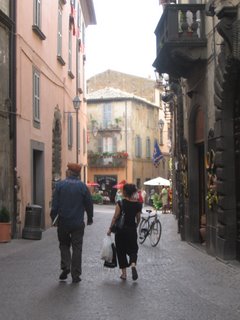
We came to the Italian hill town/city of Orvieto in western Umbria on our jaunt to the coast. It was one of the "unscheduled" delights of the trip - winding medieval streets with walls bedecked with flowers, shops, bars, bookstores, restaurants, young people dressed in everything from solid colors, punkish, scarved, or neo-hippie threads all in an an unassumingly elegant styl, (sprezzatura, again);everywhere friendly laid-back people, patient with my earnest but creaky italian, who went out of their way to guide and give directions.
Beneath the city, dating from Etruscan times, lies a "subterranean city", a staggering maze of paths, cellars, grottos and shelters, carved from the resilient volcanic tufa stone that is the base of the town's buildings.
We left with a contented mellow buzz, reflecting, even now, on our luck. As we left we gazed back at Orvieto from a distance through the rolling hills of fruit trees and cypresses, looking like a town from a fairy-tale, nestled outside of time, high on the steep cliffs.
It was only after we got back to Arizona that I found out that Orvieto was a Slow City , one of some 50-plus Italian cities belonging to the "Citta Slow" movement. The Cittaslow grew out of the "Slow Food" movement which still thrives and was, essentially, a reaction against the burgeoning fast food "americanisation" of Europe. Cittaslow encourages an appreciation of the individuality of place rather than quick-fix global, corporate, sameness running roughshod over the unsuspecting. At the same time, it acknowledges the use of 'green' technologies and does not intend to step aside from the modern world and turn these towns into quaint tourist museums.
Quoting an article from The New Internationalist magazine Mar 2002,
"The Slow city program involves enlarging parks and squares and making them greener, outlawing car alarms and other noises that disturb the peace, and eliminating ugly TV aerials, advertising posters and neon signs.
Other priorities include the use of recycling, alternative energy sources and ecological transportation systems. The movement rejects the notion that it is anti-progress and holds that technologies can be employed to improve the quality of life and natural urban environment."
Of course "indigenous" traditional crafts, and cuisines are encouraged, and support of local growers.
Though obviously a tourist draw, these cities are managing to use the influx to benefit the continuity of local culture. Many younger 'exiles" of these towns are returning to work in the revived economy. If anything, a shortage of available workers has been a concern.
There are still a lot of kinks to work out but the movement seems to be gaining ground, slowly...
for more info on Cittaslow;
http://www.slowmovement.com/slow_cities.php
www.slowfood.com

3 comments:
Winding medieval streets and subterranean cities. Lovely!
I just found out that Orvieto had been a stronghold for the "Cathars" in the late 12th century. Odd, in that it was somewhat sanctioned by the Papal state (although it was one of the few very self reliant and independent towns for that time) judging on the fate of the Cathars in the south of France i can imagine they eventually had to take refuge in the Subterranean city...awaiting the book from "Power and Purity" by Janet Lansing from Inter-library loan to find out more.
- subterranean-wino
I'm trying to slow down.In fact, I made myself a grilled cheese sandwich on July 13,2005 and tomorrow morning I'm going to take my fifth bite.
Post a Comment